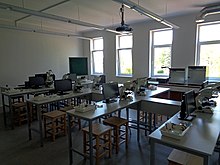Bromatology
The science of food or bromatology is the natural science dedicated to the study of food. It is often confused with 'food technology'. The Institute of Food Technologists defines food science as "the discipline in which engineering, biological and physical sciences are used to study the nature of foods, the causes of spoilage, the principles underlying food processing and improving food for the consumer". The textbook Food Science defines food science in simpler terms as "the application of basic science and engineering to study the physical, chemical and biochemical nature of food and the principles of food processing".
In cooking, bromatology is defined as the science that studies the production, handling, preparation and distribution of food, as well as its relationship with health. Its objective is to generate conscious and responsible gastronomy professionals in terms of safety and hygiene regulations, which limit the incidence of so-called Foodborne Diseases (ETA).
The activities of food technologists include the development of new food products, the design of processes to produce these foods, the selection of packaging materials, shelf life studies, sensory evaluation of products through survey panels or potential consumers, as well as microbiological and chemical testing. Food scientists can study more fundamental phenomena that are directly related to the production of food products and their properties.
Food science brings together multiple scientific disciplines. It incorporates concepts from fields such as chemistry, physics, physiology, microbiology, biochemistry, among others. Food technology incorporates concepts from chemical engineering, for example.
Disciplines
Some of the sub-disciplines of food science are described below.
Food Chemistry
Food chemistry is the study of chemical processes and interactions of all biological and non-biological components of food. Biological substances include items such as meat, poultry, lettuce, beer, and milk as examples. It is similar to biochemistry in its major components, such as carbohydrates, lipids, and proteins, but also includes areas such as water, vitamins, minerals, enzymes, food additives, flavors, and colors. This discipline also encompasses how products change under certain food processing techniques and ways to improve or prevent them from happening.
Physicochemistry of food
Food physicochemistry is the study of physical and chemical interactions in food in terms of physical and chemical principles applied to food systems, as well as the application of physicochemical techniques and instruments for the study and analysis of food food.
Food Engineering
Food engineering is the industrial process used to manufacture food.
Food Microbiology
Food microbiology is the study of microorganisms that inhabit, create, or contaminate food, including the study of microorganisms that cause food spoilage. However, "good", like probiotics, are becoming increasingly important in food science. In addition, microorganisms are essential for the production of foods such as cheese, yogurt, bread, beer, wine, and other foods. fermented.
Food Packaging
Food preservation
Food preservation involves the causes and prevention of quality deterioration.
Food Substitution
Food substitution refers to the replacement of fat, sugar, or calories in a product while maintaining a similar shape, texture, color, or flavor.
Food Technology
Food technology is the technological aspect. The first scientific research on food technology focused on food preservation. Nicolas Appert's development in 1810 of the canning process was a watershed event. The process was not called canning at the time and Appert didn't really know the principle on which his process worked, but canning has had a major impact on food preservation techniques.
Molecular gastronomy
Molecular gastronomy is the scientific investigation of processes in the kitchen, gastronomic, social and artistic phenomena. Molecular gastronomy is a subdiscipline of food science that seeks to investigate the physical and chemical transformations of ingredients that occur in cooking. kitchen. Its program includes three axes, since it was recognized that cooking has three components, which are social, artistic and technical.
New product development
New product development includes the invention of new food products.
Quality control
Quality control involves the causes, prevention, and communication related to foodborne illness.
Quality control also ensures that the product meets specifications to ensure that the customer receives what they expect from the packaging with the physical properties of the product itself.
Sensory analysis
Sensory analysis is the study of how consumers' senses perceive food.
By country
Australia
The Commonwealth Scientific and Industrial Research Organization (CSIRO) is the federal government agency for scientific research in Australia. CSIRO maintains more than 50 sites in Australia and biological control research stations in France and Mexico. It has about 6,500 employees.
South Korea
The Korean Society for Food Science and Technology, or KoSFoST, claims to be the first society in South Korea for food science.
United States
In the United States, food science is typically studied at land-grant universities. Many of the nation's pioneering food scientists were women who had attended chemistry programs at land-grant universities (which were state-run and largely under state mandates to allow blind people admission), but then they graduated and had a hard time finding a job due to pervasiveness Sexism in the chemical industry in the late 19th century and early XX. Finding conventional career paths blocked, they found alternative employment as instructors in home economics departments and used it as the foundation to launch the foundation of many modern food science programs.
The leading organization in the US for food science and food technology is the Institute of Food Technologists (IFT), based in Chicago, Illinois, which is the member organization of the International Union of Food Science and Technology (IUFoST) of the USA.
Further reading
- Wanucha, Genevieve (24 February 2009). "Two Happy Clams: The Friendship that Forged Food Science." MIT Technology Review.
Contenido relacionado
Fish flour
Lupinus mutabilis
Pasteurization
Mackerel
Grain






